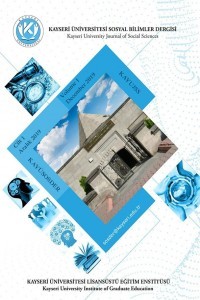Asya resim sanatında mürekkep tekniklerine dair bir seçki
Bu çalışma, Doğu Asya uygarlıklarına ait olan bazı mürekkep tekniklerini, benzerlik ve farklılıkları ile değerlendirmeyi amaçlamıştır. Bu karşılaştırma hem teknik hem de kavramsal boyutta ele alınmıştır. Ele alınan teknikler; Baimiao, Nanga, Haiga, Zenga, Ensō (Zen Daireleri), Sumi-e, Estamp ve Lavi’dir. Uygulama olarak farklılık gösteren bu tekniklerin ortak yanları, Zen Budizm felsefeleriyle bağlantılı olmalarıdır. Çok renkli olmayan tekniklerin diğer ortak yanı ise, yaşamın içinden ele alınan bir konunun, görüntüsünün ötesindeki kavramsal derinliklerdir. Bu az renkçi ve sade anlayış, Zen felsefesine dayanmaktadır. Sıklıkla, su ve mürekkebin kullanıldığı bu tür çalışmalarda resim yapılan yüzeyin beyazlığı da önemli bir eleman olmuştur. Tüm bu özellikler çalışmadaki örnek görsellerde izlenmektedir. Öte yandan, mürekkep malzemesinin ve bu tekniklerin, Doğu Asya medeniyetlerinin zenginleşmesinde olduğu kadar, tüm dünyada güzel sanatlar alanında çeşitli tekniklerin gelişiminde önemli katkıları olmuştur.
A selection of ink techniques in Asian painting
This study aimed to evaluate specific ink technics of East Asian civilizations with their similarities and differences. This comparison was handled in both technical and conceptual dimensions. The technics handled were Baimiao, Nanga, Haiga, Zenga, Ensō (Zen Circles), Sumi-e, Estamp and Lavi. A common ground of these technics which vary in terms of application is that they are connected with Zen Buddhism philosophies. Another common ground of the technics which are not so colorful is the conceptual depths of a subject handled from within life beyond its appearance. This less colorist and simple understanding is based on Zen philosophy. In such works that often use water and ink, whiteness of the painting surface has also been a significant element. All these properties are observed in example images in the study. In addition, the ink material and these technics have made noteworthy contributions to the development of a variety of technics in the area of fine arts worldwide, as much as in the enrichment of East Asian civilizations.
___
- Baekeland, F. (1990). The art of Zen: Paintings and calligraphy by Japanese Monks, 1600- 1925, by Stephen Addiss. Sophia University Publications, (45), 119-121.
- Bashō, M. (Edo Dönemi). Melon Blossom [Painting]. Japan. https://www.talialehavi.com/post/painted-poetry-or-poetic-painting
- Buson, Y. (Edo Dönemi). Spring Landscape [Painting]. Nanga School, Japan. https://www.pinterest.es/pin/501799583451073813/
- Buson, Y. (1771). Selfportrait [Painting]. Japan. https://www.wikiart.org/en/yosa-buson
- Cançat, A. (2023). Resim teknikleri ansiklopedisi. İstanbul Gelişim Üniversitesi Yayınları.
- Cheng, L. (10. yy). Luxuriant Forest among Distant Peaks (detail) [Painting]. Liaoning Provincial Museum, China. https://en.wikipedia.org/wiki/Ink_wash_painting
- Ekun, F. (1650). Hotei Pointing at the Moon [Painting]. Metropolitan Museum of Art, New York, ABD. https://www.metmuseum.org/art/collection/search/77179
- Enji, T. (Edo Dönemi). Ensō (Zen Circle). [Painting]. Japan. http://www.manyoancollection.org/work/enso-zen-circle/
- Guosong, L. (t.y.). Emerald Gorge [Painting]. Private Collection.https://en.wahooart.com/@@/ AQQR6W-Liu-Guosong-Emerald-Gorge
- Hiroshige, U. (1840-1842). Odawara [Painting]. Private Collection. https://collections.artsmia.org/art/ 61009/odawara-utagawa-hiroshige
- Hokusai, K. (1830). Bamboo shoots [Painting]. Japan https://www.loc.gov/pictures/collection/jpd/ item/2009631927/
- Hokusai, K. (1830). Three birds perched on branches, one with blossoms [Painting]. Hokusai School sketchbook, Japan. https://commons.wikimedia.org/wiki/File:Three_birds_perched_on_ branches,_one_with_blossoms_LCCN2009631926.jpg
- Hokusai, K. (1830). Hotei [Painting]. Hokusai Sketchbook, Japan. https://www.loc.gov/exhibits/ukiyo-e/images/116s.jpg
- Jungman, B. (1995). Confusing traditions: Elements of the Korean an Kyŏn school in early Japanese Nanga landscape painting. Switzerland (Museum Rietberg), Artibus Asiae Journals, (55), 303-318.
- Kay, M. T. (2017). The art and technique of Sumi-e Japanese ınk painting: Japanese ink painting as taught by Ukao Uchiyama. Tuttle Yayınevi.
- Kurtulan, M. (2021). Orta ve Batı Asya sanatında mürekkep resmi geleneği ve hayvan mücadele sahneleri. Lale Kültür Sanat ve Medeniyet Dergisi, 52-64.
- Seo, A.Y. (2007). Ensō: Zen Circles of Enlightenment. Weatherhill Publisher.
- Socho, T. (1995). Haiga: Takebe Socho and the Haiku-Painting Tradition. University of Hawaii Press/Marsh Art Gallery.
- Zeng, F. (Edo Dönemi). Dharma [Painting]. Japan.
- ISSN: 2687-5772
- Yayın Aralığı: Yılda 2 Sayı
- Başlangıç: 2019
- Yayıncı: Kayseri Üniversitesi
Sayıdaki Diğer Makaleler
Makine Öğrenmesi İle Eksik Veri Tamamlama Yöntemlerinin Sınıflandırma Performansına Etkileri
Şemsettin ERKEN, Levent ŞENYAY
Asya resim sanatında mürekkep tekniklerine dair bir seçki
Deprem nedeniyle nakil gelen öğrencilerin sınıflarına kabul durumlarının belirlenmesi
Enver TÜRKSOY, Ridvan KARABULUT, Melike GÜRBÜZ
Osman İbni Monla Ahmed’in Mecalis isimli eserinde "ısar" gelecek zaman eki üzerine notlar
Ridvan KARABULUT, Ahmet KUCUR, Fatih YILDIZİLİ, Gürbüz ÇETİN, Sedat EROĞLU
